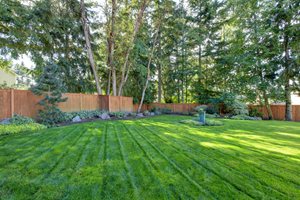Seeding a Lawn with Grass Seed
When to choose a hand-seeded lawn
A seeded lawn takes more effort to get established, but is more resistant to disease and pest issues than sod.
When growing a lawn from seed, you have two options: hydroseeding or hand-seeding. For very small spaces, hand-seeding is an inexpensive option that is great for homeowners. However, it’s not without its drawbacks. Learn more about installing a lawn by hand using grass seed.
Pros and cons of a hand-seeded lawn
Pros:
- Inexpensive.
Scattering a blend of seed over your lawn is the most inexpensive route and doesn’t usually require a professional’s touch, though you may wish to hire a contractor to help with sprinkler systems, bed preparation, and edging. - Great for small spaces.
While hydroseeding is an efficient and cost-effective option for large spaces, the initial expense of setting up the machine means that you don’t save much money when installing a smaller area of lawn. This makes hand-seeding a more attractive choice for petite spaces. - No overspray.
Hydroseeding machines blow a mixture of mulch and seed through a hose out onto your lawn, and it’s common to get a little overspray into garden beds. When hand-seeding, you can aim your seed more carefully and won’t end up having to weed lawn sprouts out of your flowerbeds. - Fewer pest problems than sod.
Though we think of turfgrass as a single type of plant, in fact there are many different types of lawn grass. Sod lawns use a single variety, while seeded lawns usually utilize a blend of seeds. By using more than one type of grass, you improve your lawn’s resistance to pest and disease issues.
Cons:
- Lower germination rates.
When hydroseeding, the papery mulch used in the mixture keeps the seeds toasty and encourages good germination. While you can use straw for mulch when hand seeding, it’s not as effective at warming the soil, so you may need to apply seed multiple times. - Seeded lawns require more care to establish than sod.
Seeded lawns of any kind require you to water multiple times a day and stay off the turf for the first two months as it becomes established. Sod, by contrast, only needs two weeks of special care and can tolerate foot traffic from the very first day.
Grass seed installation process
Installing grass seed by hand is similar in many ways to installing a hydroseeded or sod lawn, with a few key differences.
- Prepare your lawn area by installing irrigation, removing stones and debris from the soil, and adding edging materials.
- Grade the soil down 2 1/2 inches below your finished grade. The finished grade is usually the same level as your patio or pathways.
- Topdress the soil with 2 inch layer of topsoil-compost mix, then regrade the soil to be completely smooth and flat. The topsoil and compost mix provides a soft, friable material to help your seeds sprout effectively.
- Treat the soil with lime to adjust the pH to be more alkaline, which is what lawn prefers.
- Use a broadcast spreader to apply the seed blend over the soil surface.
- Gently rake the soil surface to achieve good contact between the seeds and the soil. Make sure you don’t bury the seeds any deeper than 1/8 of an inch.
- Scatter a thin layer of straw over your seeds to hold moisture, prevent runoff, and keep the seeds warm. The straw also provides a minimal amount of protection from birds, which may try to eat your grass seed.
- Keeps seeds moist as they sprout, watering as often as three times a day so your germinating seeds never dry out. Your new lawn will need attentive watering for the first two months.
- Keep foot traffic to a minimum and don’t allow children or pets to walk on the lawn until it is full and lush.
- Mow your lawn for the first time one month after germination, then mow as needed.
- When seeding a lawn by hand, you may need to apply seed multiple times in order to get even coverage and a thickly-growing stand of turfgrass.

 Backyards
Backyards
 Front Yards
Front Yards





